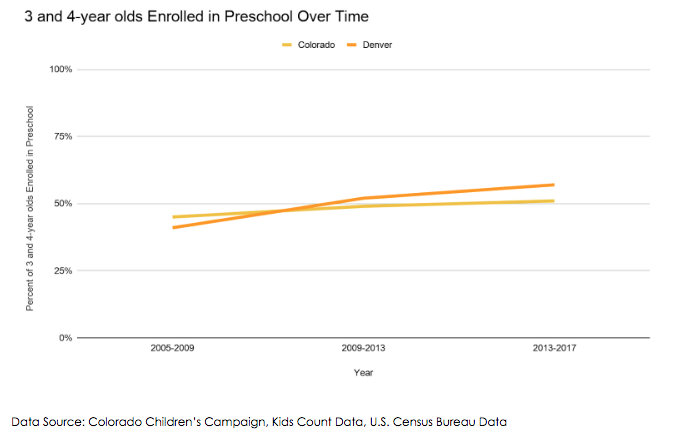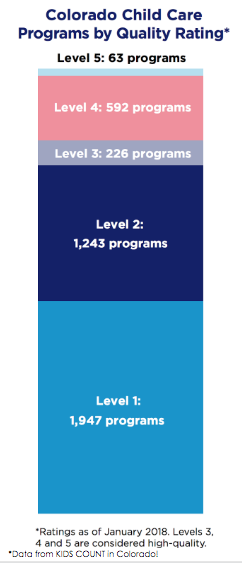
Erin Ellis, Office Support II from Denver Public Schools Early Education Department asked, How has Early Childhood Education improved in Denver Public Schools over the last 15 years? How can families and community members become more actively involved so that the gains and/or challenges that are being seen are equitable across all groups of students?
Denver Public Schools faces severe access and equity issues when it comes to Early Childhood Education (ECE). Two key programs the City of Denver has to help families access ECE programming are Head Start and the Denver Preschool Program (DPP). Both help families, although the support they offer still fails to meet the demand for ECE slots. In particular, this inequity is aggravated by geographical limitations, leading to childcare deserts which follow familiar economic and demographic lines.
Part I: Improvement in ECE Over Time (Investments, Quality, Access, & Equity)
ECE Over Time: Key Investments and Programs
Denver Preschool Program (DPP)
- DPP is funded through a sales tax approved by Denver Voters in 2006. It started administering benefits in 2007.
- Its primary functions are to provide tuition support and information to families. In a given year, around $15 million are disbursed as tuition support and program supports to help approximately 5,000 students. DPP gives greater tuition support to higher-rated schools, trying to increase preschool quality and access for Denver families. (Butler Institute for Families).
Great Kids Head Start (and other Head Start Grantees)
- “The five Early Head Start and Head Start grantees collectively served approximately 26 percent of the eligible population in 2017,” which translates to approximately 2,000 students overall(Denver Children’s Affairs).
Defining Quality in Early Childhood Education
- The Colorado Shines program, established in 2015 by the Office of Early Childhood, housed by the Department of Human Services, has a widely-used quality rating system.
- The five-star rating system provides a rating to Preschools and Early child care centers as a way to communicate quality to families. Colorado Shines is tasked with licensing and improvement services as well.
- In programs like the Denver Preschool Program, families applying for assistance to have their child attend 4 or 5-star programs will receive more funding than a 3-star program (Padres y Jóvenes Unidos).
ECE Quality and Access
“Unfortunately, among the 41 states with state-supported preschool programs, Colorado ranks 37th in spending, 22nd in access to preschool for four-year-olds and 10th in access for three-year-olds.”
Although Colorado’s state spending on preschool is low by comparison, the Colorado Preschool Program (CPP) is an effective program that meets six out of 10 quality standards of the National Institute for Early Education and Research and consistently shows school readiness gains for Colorado’s most at-risk children. ” -Colorado Children’s Campaign
The National Institute for Early Education and Research creates state profiles for every state as a rough evaluation on whether each state meets some key benchmarks. Colorado falls short on teacher licensing standards, meal provisions, and health care screenings and supports.
Access to Early Childhood Education
A+ Answers Takeaways and Questions:
- Denver has consistently increased the percentage of 3 and 4-year olds enrolled in preschool over time.
- How much of this trend reflects policy changes and investments, compared to changing demographics?
Data note: These data come from the U.S. Census Bureau’s American Community Survey. These population estimates are based on five years of data to improve accuracy and reliability.
Access and Equity of ECE
The Center for American Progress recently published a report on child care deserts, illuminating the profound equity issues faced. A large part of equity, beyond financial, is geographical limitations. There are many neighborhoods in the Far Northeast and South West Denver leading into Aurora that are in child care deserts with few child care centers. As a report by Padres y Jóvenes Unidos shows, the picture looks even more grim when the quality of child care options are considered.
One factor that limits ECE participation is affordability. The report by Padres y Jóvenes Unidos examines this issue more deeply. It shows clearly that existing programs don’t fully meet the existing demand.
The report also surveys community members to help create a deeper understanding of what the barriers are to equitable access to ECE.
Part II: Opportunities for Engagement and Involvement
ECE Family and Community Involvement
- Academic Partnership between parents and teachers is critical for a student’s success. A recent study by Learning Heroes suggests that 90% of parents think their students are on grade level when data suggests that number is significantly lower.
- Closing this “partnership gap” is critical so that parents can truly understand where their students need support. One strategy that is used by early childhood and K-12 systems that is a highly effective way of both building relationships is home visits.
- John Hopkins recently conducted a study that suggested home visits have the potential to interrupt bias in educators, increase attendance and when executed alongside other strategies, increase performance on assessments.
Want to learn more about ECE? Check out these resources:
- Colorado Children’s Campaign. Early Childhood Care and Education. Retrieved from https://www.coloradokids.org/early-childhood/
- Padres y Jóvenes Unidos. (2016, February). The Great Unequalizer: How Denver’s Pre-K System Fails the Children of Southwest Denver and Other Low-Income Communities (Rep.). Retrieved from http://padresunidos.org/wp-content/uploads/2016/11/ece_reportENG.pdf
- Malik et al. (2018, December 6). America’s Childcare Deserts in 2018 (Rep.). Retrieved https://www.americanprogress.org/issues/early-childhood/reports/2018/12/06/461643/americas-child-care-deserts-2018/
This question came from Erin Ellis, Office Support II from Denver Public Schools Early Education Department, as part of A+ Answers, a community-driven research and reporting project, where we answer your questions to empower conversations about education in Colorado.
Have a different question you want answered? Get in contact with us!

